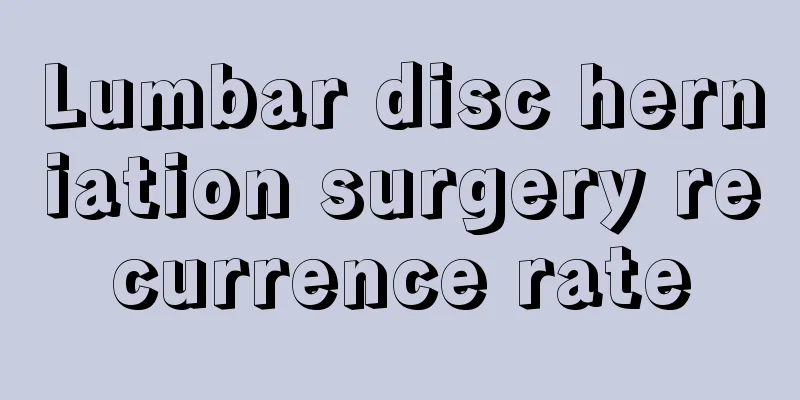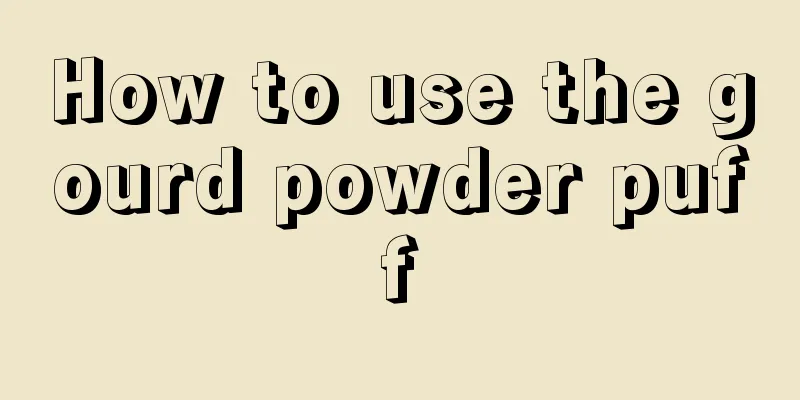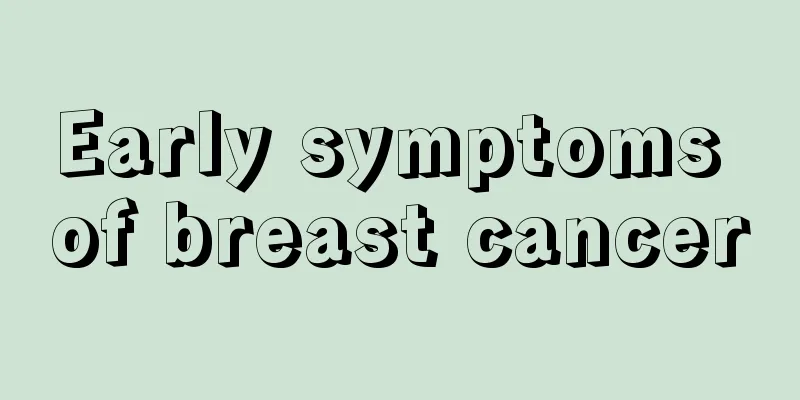Lumbar disc herniation surgery recurrence rate

|
Surgical treatment is a method often used by hospitals for patients. The advantage of surgical treatment over drug treatment is that it can quickly remove the source of the disease. In the later stage, combined with drug treatment and bed rest, the patient can recover quickly. Moreover, many sudden diseases are also treated with surgery. For example, appendicitis may occur in an instant and the surgery can be performed quickly. Surgery is not a permanent solution, and recurrence is possible. So what is the recurrence rate of lumbar disc herniation surgery? Minimally invasive surgery Minimally invasive surgery will leave some nucleus pulposus tissue, and the remaining nucleus pulposus tissue is the pathological basis for the recurrence of lumbar disc herniation, so the recurrence rate of minimally invasive surgery will be higher than that of general open surgery. Open surgery Open surgery is more risky than minimally invasive surgery because it is more traumatic, requires the removal of more tissue structures, can easily destroy the stability of the lumbar spine, and requires more stringent postoperative care and rehabilitation. In addition, it is generally recommended abroad that patients with lumbar disc herniation should undergo rehabilitation treatment for about 3 months. If it is ineffective, surgery should be performed. In addition, about six weeks of preoperative rehabilitation exercises are required before surgery to strengthen the waist muscles (this helps postoperative recovery, especially since open surgery requires a long period of bed rest, during which time the waist muscles are prone to atrophy). Lumbar disc herniation is one of the more common diseases. It is mainly caused by different degrees of degenerative changes in the various parts of the lumbar disc (nucleus pulposus, annulus fibrosus and cartilage plate), especially the nucleus pulposus. Under the influence of external factors, the annulus fibrosus of the intervertebral disc ruptures, and the nucleus pulposus tissue protrudes (or falls out) from the rupture to the back or inside the spinal canal, causing the adjacent spinal nerve roots to be stimulated or compressed, resulting in a series of clinical symptoms such as low back pain, numbness and pain in one or both lower limbs. The highest incidence of lumbar disc herniation is at L4-5 and L5-S1, accounting for about 95%. Summary of treatment methods: 1. Non-surgical treatment Most patients with lumbar disc herniation can be relieved or cured through non-surgical treatment. The treatment principle is not to restore the degenerated and protruding intervertebral disc tissue to its original position, but to change the relative position of the intervertebral disc tissue and the compressed nerve root or partially retract it, thereby reducing the pressure on the nerve root, loosening the adhesion of the nerve root, eliminating the inflammation of the nerve root, and thus alleviating the symptoms. Non-surgical treatment is mainly suitable for: 1. young patients, first-time patients or patients with a short course of illness; 2. patients with mild symptoms that can be relieved by themselves after rest; 3. patients with no obvious spinal stenosis on imaging examination. (1) Absolute bed rest: When the disease first occurs, you should strictly rest in bed, and emphasize that you should not get out of bed or sit up to urinate or defecate. This will achieve better results. After 3 weeks of bed rest, you can get up and move around while wearing a waist belt for protection, and do not bend over or hold objects for 3 months. This method is simple and effective, but difficult to stick to. After remission, you should strengthen your back muscle exercises to reduce the chance of recurrence. (2) Traction therapy uses pelvic traction to increase the width of the intervertebral space, reduce the intradiscal pressure, retract the protruding disc, and reduce stimulation and compression on the nerve roots. It needs to be performed under the guidance of a professional doctor. (3) Physical therapy and massage can relieve muscle spasms and reduce pressure in the intervertebral disc, but be aware that violent massage can aggravate the condition and should be used with caution. (4) Supportive treatment: Glucosamine sulfate and chondroitin sulfate can be tried for supportive treatment. Glucosamine sulfate and chondroitin sulfate are clinically used to treat osteoarthritis in various parts of the body. These chondroprotective agents have a certain degree of anti-inflammatory and anti-cartilage decomposition effects. Basic research shows that glucosamine can inhibit the production of inflammatory factors by spinal nucleus pulposus cells and promote the synthesis of glycosaminoglycans, a component of the intervertebral disc cartilage matrix. Clinical studies have found that injecting glucosamine into the intervertebral disc can significantly reduce lower back pain caused by degenerative disc disease and improve spinal function. Case reports suggest that oral glucosamine sulfate and chondroitin sulfate can reverse disc degeneration to some extent. (5) Corticosteroids Epidural injection of corticosteroids is a long-acting anti-inflammatory agent that can reduce inflammation and adhesions around nerve roots. Generally, long-acting corticosteroid preparations + 2% lidocaine are used for epidural injection once a week, 3 times as a course of treatment, and another course of treatment can be used after 2 to 4 weeks. (6) Chemical nucleus pulposus dissolution uses collagenase or papain, which is injected into the intervertebral disc or between the dura mater and the protruding nucleus pulposus. It selectively dissolves the nucleus pulposus and annulus fibrosus without damaging the nerve roots, thereby reducing the pressure in the intervertebral disc or reducing the size of the protruding nucleus pulposus, thereby alleviating symptoms. However, this method carries the risk of allergic reactions. 2. Percutaneous nucleotomy/laser vaporization of the nucleus pulposus Through the use of special instruments, the intervertebral space is entered under X-ray monitoring, and part of the nucleus pulposus is crushed, sucked out or vaporized by laser, thereby reducing the pressure within the intervertebral disc and relieving symptoms. It is suitable for patients with bulging or mild herniation, but not suitable for patients with lateral recess stenosis or obvious herniation, or those whose nucleus pulposus has prolapsed into the spinal canal. 3. Surgery (1) Indications for surgery: ① Patients with a history of more than three months, who have no effect on strict conservative treatment or who have been effective with conservative treatment but have frequent relapses and severe pain; ② Patients with severe pain, especially in the lower limbs, who have difficulty moving and sleeping and are in a forced posture; ③ Patients with cauda equina compression; ④ Patients with single nerve root paralysis, accompanied by muscle atrophy and decreased muscle strength; ⑤ Patients with spinal stenosis. (2) Surgical method: Through a posterior lumbar incision, partial resection of the lamina and articular processes, or disc resection through the interlaminar space. For central disc herniation, laminectomy is performed followed by epidural or intradural discectomy. Patients with lumbar instability and lumbar spinal stenosis require spinal fusion surgery at the same time. In recent years, minimally invasive surgical techniques such as microdiscectomy, microendoscopic discectomy, and percutaneous transforaminal endoscopic discectomy have reduced surgical damage and achieved good results. |
<<: What is the reason why I snore when I sleep recently?
>>: What are the different types of lip shapes
Recommend
How to wash your face after eyelash extensions
For those who love beauty, eyelash extensions are...
Can I put things on top of the refrigerator?
In life, many people put some things on top of th...
What are the effects and functions of Ligustrum lucidum
There are many names for the fruit of Ligustrum l...
What are the early symptoms of prostate cancer?
Prostate cancer often occurs in the posterior lob...
What should I do if I have the skin disease pityriasis rosea?
Skin diseases have always been a type of disease ...
How is prostate cancer diagnosed? What tests should prostate cancer patients undergo?
Nowadays, it is generally not difficult to diagno...
Symptoms of bladder cancer that are easy to occur in life
There are many diseases in the bladder area, and ...
What are the causes of flat back syndrome
We all know that under normal circumstances, our ...
Does surgery to repair a perforated eardrum hurt?
Eardrum perforation cannot be said to be serious ...
How long does it take to recover from hormone allergy
I believe that many people do not know the functi...
I fart over 100 times a day
If a person farts in public and that fart is smel...
What is the cause of sore throat
Throat pain can be caused by a wide range of dise...
What causes small pits on nails?
Small pits on the nails are a common problem for ...
How to remove spots from persimmon leaves?
Persimmon is a very common fruit with high nutrit...
How to wash clothes without fading?
Many people are troubled by the fading of clothes...









